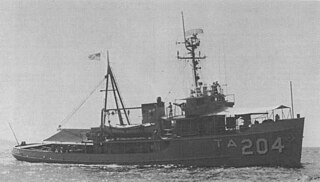
USS Algonquin, completed as El Toro in 1891 for the Southern Pacific Railroad's Morgan Line, was a small harbor tug commissioned by the United States Navy 2 April 1898. Renamed Accomac, after Accomac, Virginia, June 1898, renamed Nottoway in 1918 and, after the Navy adopted alphanumeric hull numbers on 17 July 1920, classified as YT-18, a district tug. On 5 October 1942 the name was cancelled and the tug was simply YT-18 until 1944 when classification was changed to YTL-18, a little harbor tug. Over the years as a Navy tug, from 1898 to 1946, the tug served from Cuba to Boston.
USS Urdaneta – occasionally misspelled Undaneta – was an iron-hulled gunboat in the United States Navy. She was named for Spanish friar and explorer Andres de Urdaneta.

USS Nashville (PG-7), a gunboat, was the only ship of its class. It was the first of three ships of the United States Navy to hold the name Nashville.
USS Napa (AT-32), originally Yucca, was a Bagaduce-class fleet tug of the United States Navy. The ship was laid down as Napa on 5 March 1919, at the Puget Sound Naval Shipyard, Washington; launched on 24 July 1919; and commissioned on 5 December 1919, Lt. W. R. Giddens in command.

USS Pawtucket, was a district harbor tug serving in the United States Navy in the early 20th century, during both World War I and World War II. This was the first of two US Navy namesakes of the city of Pawtucket, Rhode Island, and the Native American tribe bearing the same name.

USS Topeka (PG-35) was a gunboat of the United States Navy.

USS Sandoval (1895) was an Alvarado-class gunboat acquired by the United States Navy from the Spanish as a prize-of-war. Duties assigned her by the Navy included patrolling coastal and river waterways, and, later, acting as a "practice ship" for the United States Naval Academy at Annapolis, Maryland and for the New York Naval Militia as well.
Four ships of the United States Navy have been named Cherokee, after the Cherokee Native American tribe.

Walter Selwyn Crosley was an officer in the United States Navy. He was a recipient of the Navy Cross, the second highest military decoration for valor. He subsequently advanced to the rank of rear admiral, to date from February 17, 1927, and was transferred to the Retired List in that rank on November 1, 1935.

The second USS Suwannee and third USS Mayflower was a United States Lighthouse Board, and later United States Lighthouse Service, lighthouse tender transferred to the United States Navy in 1898 for service as an auxiliary cruiser during the Spanish–American War and from 1917 to 1919 for service as a patrol vessel during World War I. She also served the Lighthouse Board and in the Lighthouse Service as USLHT Mayflower from 1897 to 1898, from 1898 to 1917, and from 1919 to 1939, and in the United States Coast Guard as the first USCGC Mayflower (WAGL-236) in 1939 and from 1940 to 1943 and as USCGC Hydrangea (WAGL-236) from 1943 to 1945.
USS Don Juan de Austria was a U.S. Navy gunboat. Formerly a Spanish Navy Velasco class unprotected cruiser, she was captured in 1898 during the Spanish–American War and commissioned into the U.S. Navy.

The fourth USS Scorpion was a steam yacht in commission in the United States Navy from 1898 to 1899, 1899 to 1901, and 1902 to 1927.

The second USS Wandank (ATA-204), originally USS ATA-204, was a United States Navy auxiliary ocean tug in commission from 1945 to 1947 and again from 1952 to 1971. The ship is possibly best known for supporting scientific operations in the Marianas, in particular serving as communication relay and support ship for the bathyscaphe Trieste in Project Nekton; she towed the bathyscaphe some 260 nautical miles from Guam to the vicinity of the Challenger Deep, where, on 23 January 1960, Trieste descended to a record 10,911 metres.
HMS Bahamas (K503) was a Colony-class frigate of the United Kingdom that served during World War II. She originally was ordered by the United States Navy as the Tacoma-class frigateUSS Hotham (PF-75) and was transferred to the Royal Navy prior to completion.
HMS Barbados was a Colony-class frigate of the United Kingdom that served during World War II. She originally was ordered by the United States Navy as the Tacoma-class patrol frigateUSS Halsted (PF-76) – sometimes spelled Halstead – and was transferred to the Royal Navy prior to completion.

USLHT Mangrove was a lighthouse tender in commission in the fleet of the United States Lighthouse Board from December 1897 to April 1898 and from August 1898 to 1910, in the United States Lighthouse Service from 1910 to 1917 and from 1919 to 1939, and in the United States Coast Guard from 1939 to 1941 and in 1946. She also saw commissioned service in the United States Navy as USS Mangrove on three occasions, operating as an armed supply ship from April to August 1898 during the Spanish–American War, during which she fought the last battle of that war; as a patrol vessel from 1917 to 1919 during and in the aftermath of World War I; and as a buoy tender from 1941 to 1946 during and in the aftermath of World War II.

USS Wompatuck (YT-27) was an armed tug in commission in the United States Navy from 1898 to 1931. Early in her naval career, she saw combat in the Spanish–American War and the Philippine–American War. After she was decommissioned, she was selected for conversion into the fuel oil barge YO-64, but she was lost in the early days of World War II in the Pacific before the conversion could be completed.

USS Piscataqua, later USS Piscataqua (AT-49), the third United States Navy ship of the name, was an armed tug in commission from 1898 to 1922. Early in her naval career, she saw service in the Spanish–American War, and she operated in the Philippines during and after the Philippine–American War.











